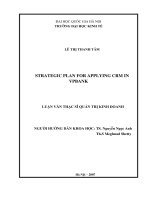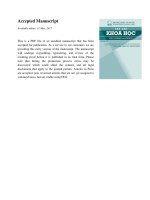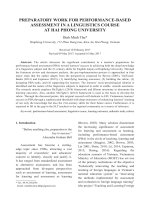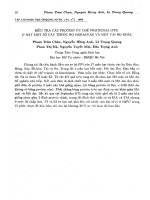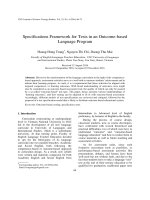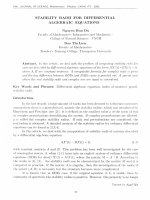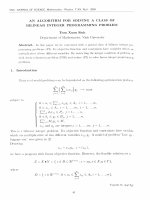DSpace at VNU: STRATEGIC PLAN FOR APPLYING CRM IN VPBANK LE THI THANH TAM
Bạn đang xem bản rút gọn của tài liệu. Xem và tải ngay bản đầy đủ của tài liệu tại đây (274.99 KB, 12 trang )
STRATEGIC PLAN FOR APPLYING CRM IN VPBANK
LE THI THANH TAM
Hanoi School of Business
Supervisors: Dr. Nguyen Ngoc Anh
Meghnad Shetty, MBA.
February 2007, 80 pages
INTRODUCTION
1. Necessity of the thesis
Joint Stock banks (JSBs) systems in Vietnam are significantly competing with State-owned banks
(SOBs) system. Because of being result of opening the economy as well as characteristics of
economy system, JSBs are controlled by Central Bank much more tight than SOBs. Besides that, set
up after SOBs they are really weak in infrastructure, competitive capacities and supported policies.
Furthermore, when Vietnam becomes member of the World Trade Organization, Joint Stock Banks
will face increasingly competitive pressure by foreign banks that have much more high power of
finance and technology.
Vietnam joint stock commercial bank for private enterprises (VPBank) is one of JSBs operating in
Vietnam banking market. It is entirely difficult for VPBank to compete with SOBs. However,
VPBank is opposing increasing competition of Joint Stock competitors in order to exist and
development.
Moreover, I have been working in VPBank, one of the first Joint Stock banks in Vietnam, as an
officer for nearly three years.
2. Objectives of the thesis
Based on defining difficulties of VPBank in terms of competing with not only other non-state banks
but also state-owned banks, the research will significantly find out a relevant competitive strategy for
VPBank in the period from 2006 to 2010 and answer Why VPBank should apply CRM as a
competitive tool.
To get the general objective the research thesis will take detail objectives: i) examining main effects
of external and internal environment on VPBank’s operation; ii) finding a relevant competitive
strategy for VPBank in next five-year period and the relationship between VPBank new competitive
strategy and CRM; and iii) how to apply CRM at VPBank.
Questions
To achieve these objectives above, the dissertation will answer three key questions follow:
1) What factors have significantly affected operations of VPBank?
2) What will be competitive strategy for VPBank in 2006 – 2010 and the relationship between
the new strategy and CRM?
3) How to apply CRM solution?
3. Methodology
To find a relevant strategy for VPBank, the thesis will analyze competitive advantages based on
analyzing SWOT and value chain.
Data is definitely collected from secondary data source. They are government’s reports, Central
Bank’s annual reports, legal documents related to banking system, VPBank’s Annual reports,
VPBank’s surveys and banking articles. Besides that, the research uses data collected from other
Joint Stock Banks and State-owned Banks.
The research also uses comparison and contrast methods in order to answer the research questions.
4. Structure of the thesis
To regard to the research topic, the research is clearly divided into three chapters including:
Chapter 1: Literature Review
Chapter 2: Background on Vietnam banking market and VPBank situation analysis
Chapter 3: Recommendation on competitive Strategy of VPBank in 2006-2010, and how to apply
CRM solution as a competitive tool.
CHAPTER 1: THEORICAL FRAMEWORK
1.1 The definition of customer relationship management (CRM):
1.1.1 Definition of customer relationship management:
There is no universal explanation of what CRM is, since the area is fairly new and still is developing.
It is therefore important to remember that several attempts of defining CRM exist and that many
companies adapt the definition to their own business and their unique needs. The following
quotations are three examples of how CRM is defined:
“CRM is a new customer-centric business model that reorients firm operations around customer
needs (as opposed to products, resources, or processes) in order to improve customer satisfaction,
loyalty and retention”
“CRM is the integration of customer focus in marketing, sale, production, logistics and
accounting, i.e. in all parts of the company’s operations and structure”
“The activities a business performs to identify, qualify, acquire, develop and retain increasingly
loyal and profitable customer by delivering the right product or service, to the right customer,
through the right channel, at the right time and the right cost. CRM integrates sales, marketing,
service, and enterprise resource planning and supply-chain management functions through
business process automation, technology solutions, and information resources to maximize each
customer contract. CRM facilitates relationships among enterprises, their customers, business
partners, suppliers, and employees”
1.1.2
Comparison between relationship and transactional marketing:
The transactional marketing focuses on the capability of taking over new customers, attracting the
potential customers from competitors while relationship marketing focuses on the capability of
protecting the market share in the market, keeping close relationship with the current customers,
cross-selling and up-selling.
1.2 The principle of CRM
The principle of CRM is that all customers are not the right customers, so in CRM each customer
group will be treated in the different ways.
The remaining customers represent potential relationship buyers. They can be divided into three
district segments:
-
Those who are significantly the most profitable;
-
Those who are delivering good profit and suggest the capability of becoming top profit
customers;
-
Those who are only marginally profitable.
The first group of buyers: Those customers who represent 10% of the company’s business
and are the most profitable should be the first to be targeted for CRM. The purpose of the
CRM efforts will be retention. Even although it may be difficult to make these customers
more profitable, CRM should help assure that none of them are lost to the competition.
The middle group of buyers: The balance of the customers in top 40% or 50% as ranked by
sales and profit. It will be just as important to target this middle group of buyers who are
delivering good profit but may be capable of moving up to the top of profit level. Customers
in this group are probably giving some of their business to your competitors. CRM activities
for these customers should be aimed directly at increasing your company’s share of their
business. CRM marketing strategy developed for this middle group of buyer more than paid
for the company’s significant investment in database software within a year.
The final, less profitable, group of customers: The third group of customers represents those
who, while profitable, are only marginally so. While it is possible that some in this group
would move up the sales ladder as a result of increased communications, it will probably not
be worth the effort. Typically, this group will represent almost half of the customer file.
Hence this simple analysis has greatly reduced the size of the challenge of implementing
CRM.
1.3 The element of CRM:
CRM consist of three elements: People, Process and Technology, that help companies to understand
their customers. To gain the success in CRM project, the company must coordinate all aspects.
Technology must be given a 20% weight, while people and business process should be 50% and 30%
respectively.
1.4 The characteristics and the challenges of CRM:
1.4.1
The characteristics of CRM:
Customer database centrally: Give to the company a overall view of relationship of each
customer.
Profitability of customer analysis: CRM helps to create the balance sheet of individual
customer, and helps the company to invest more effectively on each customer, the
profitability is the most important thing to evaluate and classify customers. Normally, each
company has three classes of customers:
-
The first class: Take about 10% of total customers, this class makes the highest profit and has
long-term transactions with the company.
-
The middle class: Take about 40%-50% of total customers, this class makes profit and is very
potential.
-
The last class: Also take about 40%-50% of total customers, the profit of this class is not high
and mainly is the current customers who have few transactions or only come to the company
in some special occasions like sale-off, discount...
Customer segmentation: CRM classifies customers into different segmentations and
measures the effectiveness of each segmentation.
Marketing campaigns base on customer database: Use the database and information of each
segmentation to plan and implement marketing campaigns
Analysis of customer’s needs: Help to give personalized product or service to each customer
and find more new and potential needs from customers to compete with competitors.
1.4.2
The challenges of CRM:
Have to change the policies and process in the whole
Need full support from the board of management and all staffs, for example: the way they
import the customer information to CRM system and dig this database...
Need large initial cost to invest on software, machine, equipment and human resource...
1.5
Ideas support CRM:
1.5.1 The statistics of Harvard-Business review in December, 1995:
-
Only 4% of dissatisfying customers complain, the other say nothing but they will come to
your competitors. In the banking industry, 65% of customer will chose other suppliers if they
are not satisfied.
-
The average person with a problem eventually tells nine other people
-
Satisfied customers tell 5 other people about their good treatment
-
The cost of acquiring a new customer is 5 to 7 times greater than retaining current ones
-
The cost of recruitment a new employee is 10 times greater than retaining current ones
1.5.2 Pareto's Principle - The 80-20 Rule:
The 80/20 Rule means that in anything a few (20 percent) are vital and many (80 percent) are
trivial. In Pareto's case it meant 20 percent of the people owned 80 percent of the wealth. In
Juran's initial work he identified 20 percent of the defects causing 80 percent of the problems.
Project Managers know that 20 percent of the work (the first 10 percent and the last 10 percent)
consumes 80 percent of your time and resources.
CHAPTER 2: BACKGROUND ON VIETNAM BANKING MARKET AND VPBANK SITUATION ANALYSIS
2.1 Overview of Vietnam Banking Market
State Commercial Bank: There are 6 banks of this type now running their business. These banks own
a large system of branches that can join Inter-bank independently or dependently owing to its policy
and management capacity or they can choose not to join Inter-bank market.
Joint-Stock Commercial Bank system consists of 37 members. It is now seeing a decline in number
but an increase in scale for each member
Joint-Venture Bank, foreign bank branches: 4 Joint-Venture Banks and 27 foreign bank branches are
in operation in Vietnam. Their customers are mainly foreign financial groups or joint-venture
companies. Several banks of this kind such as City-bank or Standard & Chartered Banks have been
offering services in Inter-bank, though still humble.
Financial companies: 5 financial companies that seem unable to afford big business due to shortage
of long-term capital want to switch to Inter-bank market. Most of these companies lack of banking
tools. These banks offer services mainly in sending and lending money, bond transactions, and
moneyed papers.
2.2 Situation of VPbank
2.2.1
Vision
Up to 2010, VPbank will become the first-ranked commercial bank in the northern of Vietnam in the
credit service; especially installment consuming loans and VPBank difference is created by effective
customer relationship management.
2.2.2
SWOT Analysis
Strength:
- Firstly, Vpbank has the quick growth rate in mobilizing funds, especially in savings. You can see
the total mobilized funds in the period 2001-2004, as below:
Total customer’s deposits in the period 2001-2004
Unit : Mil VND
Criteria
2002
2003
%
2004
%
Customer’s deposits
974,632
1,273,993
30.72%
1,869,589
46.75%
* Savings account
797,116
1,032,513
29.53%
1,541,341
49.28%
* Current account
134,697
210,371
56.18%
283,198
34.62%
42,819
31,109
-27.35%
45,050
44.81%
* Others
So, the growth rate in mobilizing fund is quick, it is because VPBank always offers the attractive
mobilized interest rate, as compared with other Vietnam commercial banks and VPbank often
provides many promotion programs or advertisements. The customer’s deposits come from 30.7% to
46.7% during the two years 2003-2004, including that savings take the most percentage.
Mobilizing fund growth rates in 2003-2004
0.76
0.47
0.40
0.33
0.24
VPbank
ACB
Exim
Techcombank Saigon Cong Thuong
Source: VPBank, ACB, Eximbank, Techcombank, Saigon Cong Thuong bank’s anual reports 20032004
- Secondly, VPBank has a young and skillful human resource. The graduated and upper graduated
employees take 74% of total employees, and two-third is the new comers. Of course, it says nothing,
the most important thing is the capability of adapting with the new environment, processing the task
but the youth will bring the fresh environment and be more active and creative.
- Thirdly, the NPLs rate over the total loan balance in VPBank is low at the current time. After
VPbank was in Hanoi state bank’s special control with the NPLs rate 37% (2001), this current rate is
only 0.5% (2004). The number can say that VPbank are operating very safely.
- Forthly, VPBank has the strong relationship in the inter-bank market. It helps VPBank increase the
profit that comes from the inter-bank market investments, securities trading…At the current time,
these activities are mainly feeding all VPBank system.
Weakness:
- Firstly, sparse experienced managers and staffs, insufficient pool of good staff for expansion
- Secondly, management and control still a distance from good banking practices
- Thirdly, lower reputation compared to leading competitors
- Fourthly, small and high risks customer base
- Fifthly, varying service quality, small range of products and services
- Sixthly, VPBank weak point is the information technology system, the software that VPBank is
applying is not very useful anymore because the demand of customers is developing; they want to
buy modern bank services. While other competitors have finished the modernizing-bank project,
VPBank still use B2K. With new application software, the competitors can deploy some new
services that attract customers like mobile-banking, home-banking…Although these services are
not popular with the medium and low income customers now, they promote brand names for
VPBank’s competitors.
Opportunity:
- Firstly, it is the high entry for the new comer. In fact, to open a new one, the legal regulations are
required so complexly. Moreover, the state bank’s guideline is to build the really strong commercial
banks to compete with the foreign ones, they do encourage opening more new small banks. With
VPBank, the domestic competitors do not arise but it is easy to appear the merge and acquisition
trend in the future. The competitors are the current domestic banks, foreign banks, and the financial
companies that provide the same services such as insurance company, post office savings, and
securities exchange…
- Secondly, Vietnam government are maintaining the market economy, so in the future the growth
rate of Vietnam economy goes up stably and firmly. This environment encourages the private
economy sector to develop; this is also the target market of other retail banks and VPBank.
- Thirdly, the habit of Vietnamese people is changing day by day, the new generation has newer
thinking, newer habit. The intellectual has the high and stable income; they want to be independent
with their parents when they are still young. It will increase the demand of instalment loans for
purchasing car, house… Besides, Vietnamese people are turning into using non-cash payment, they
will use plastic and chip payment cards like ATM, Credits card…This is the big opportunities for
banks including VPbank.
- Fourthly, the banking industry has the potential development trend and high profitability, at this
time the stocks of commercial banks are so attractive in the investors’ eyes. This opportunity still
offer to other bank like VPBank, they still keep investors’ belief because Vietnam commercial banks’
strategies are to develop stably and firmly and to reduce the risk as much as possible.
Threat:
- Firstly, SOCB reform resulting in SOCB’s targeting SME segment
- Secondly, leading competitors have accelerated
- Thirdly, foreign banks preparing for market penetration
- Fouthly, non-bank financial services: insurance, leasing, postal savings are potential threats
- Fifthly, Vietnam’s economy is still high-risk
- Sixthly, many sectors are facing difficulties with economic integration
2.2.3
Value chain analysis
After taking value chain analysis and comparing with some selected competitors. We can understand
where VPBank is standing in the market and what competitive advantages from VPbank are better
than others. VPBank does not expose anything that is the best, VPBank only has some points that are
relatively strong and able to compete (not much worse than VPBank’s competitors), they are credit
business and service after sale. In order to strengthen VPBank’s competitive advantage, they should
apply CRM.
CHAPTER 3: RECOMMENDATIONS TO BUILD A STRATEGIC PLAN FOR APPLYING CRM IN VPBANK
With the competitive strategy above in 2006-2010 period, the application plan of CRM program is
divided into 3 phases:
+ The first phase (2006-2007): Build foundation for CRM, especially VPBank customer database
REFERENCES
1. Arthur Middleton Hughes. The Customer Loyalty Solution: What Works (and
What Doesn't) in Customer Loyalty Programs. McGraw-Hill
2. Brock Richard and et al. 2000. Profitable Customer Relationships: The Keys to
Maximizing Acquisition, Retention, and Loyalty. Apastore Inc
3. Frederick Newell. Why CRM Doesn't Work: How to Win by Letting Customers
Manage the Relationship. Bloomberg
4. Michael T. Bosworth and John R. Holland. Customer Centric Selling. McGrawHill
5. Neil Woodcock, Merlin Stone and Bryan Foss. The Customer Management
Scorecard: Managing CRM for Profit. Kogan Page Limited
6. Philip Blight and Douglas Turk. CRM unplugged releasing CRM’s strategic value.
John Wiley and Sons, Inc.
7. Sarah Dougan. Customer relationship strategies in financial services. Business
Insights Lmt
8. Tom Sant. Persuasive Business Proposals: Writing to Win More Customers,
Clients, and Contracts. Amacom
9. www.guru.com
10. www.asiabanker.com
11. www.vpb.com.vn
